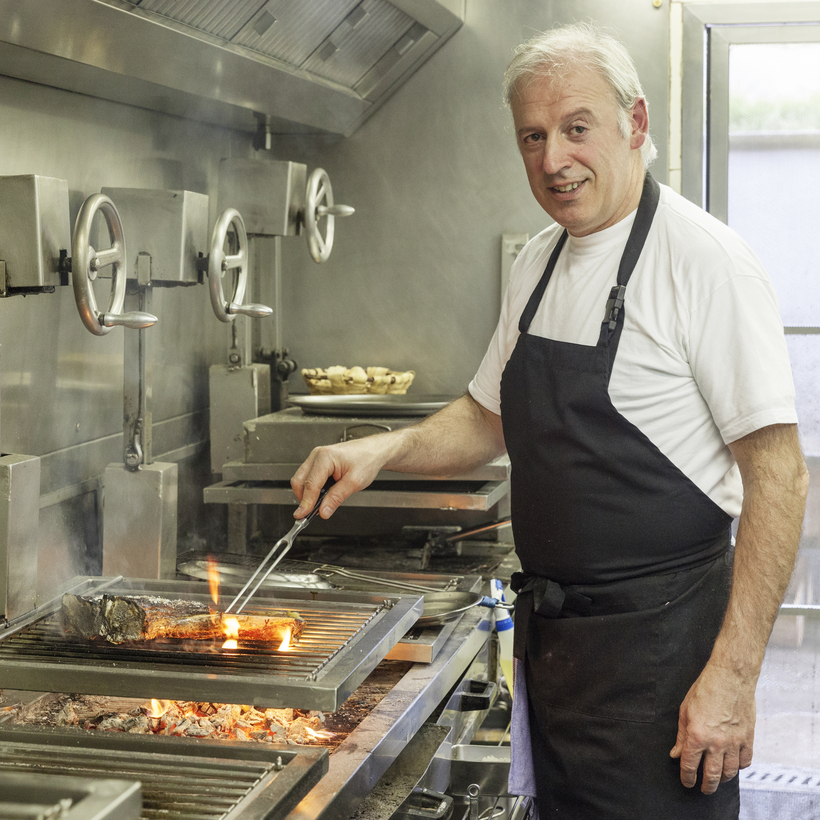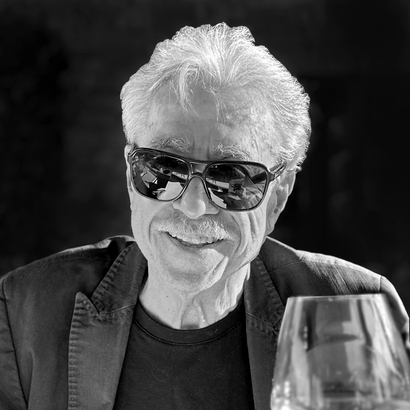I arrived early, with a mission: to find out why Etxebarri is so celebrated, even though it is fundamentally unlike any other world-famous restaurant.
For one thing, chef-owner Victor Arguinzoniz cooks his dishes, even desserts, over charcoal, made on the premises from wood stacked outside in a shed.
Cooking with charcoal goes back hundreds of thousands of years. Its use in restaurants is familiar, but Arguinzoniz has made it chic. And while his heat source has everyone entranced, his incomparable mastery of it has transformed him, at age 59, into a legend. His grill is not an immovable flat surface, like the one at your house. It is as complicated as a pipe organ, with multiple moving parts.
Arguinzoniz grew up in Axpe, in Spain’s Atxondo valley, and in Atxondo he has remained. The mountains surrounding the restaurant are modest, rocky, and, according to local lore, populated by witches. As a child, Arguinzoniz ate stews cooked in iron pots over charcoal, and he never found a reason to seek an alternate heat source.
Asked what he calls his renowned style of cooking, he replied, “The cuisine of charcoal.” He does not indulge in hyperbole.
He never found a reason to seek an alternate heat source.
Cooking over an open fire is not alien to Americans. Our culture celebrates flame broiling (Burger King), slow smoking (barbecue), and backyard blackening (supermarket briquettes). In only one way does Arguinzoniz adhere to the American ideal: he cooks not in chef’s whites but in jeans.
Etxebarri is located in an attractive, secluded hamlet, where I hoped friendly locals would enlighten me about the gastronomic treasure in their midst. The restaurant was recently upgraded to No. 3 on the S.Pellegrino World’s 50 Best Restaurants list.
I failed, not because the locals were unfriendly. Because there weren’t any. The hamlet was eerily empty. A community swing set hung unused. The six lovely stone structures clustered within a few steps of one another appeared abandoned.
No. 3 on the S.Pellegrino World’s 50 Best Restaurants list.
The bell tower rang lustily at one p.m., apparently without human assistance. If it was a call to assemble, nobody took the hint. The small message board beneath the tower contained no messages.
I wasn’t quite alone. A few steps away, behind fences, were eight sheep, six chickens, and two burros. I hoped my presence would spur curiosity and they would wander over. They did not.
In Basque country, it seems that both man and beast mind their own business.

I later asked Arguinzoniz if anyone lived in those stone structures—his restaurant is one of them—and he assured me they did. I asked if residents dined at his restaurant, where his 14-course tasting menu is 180 euros per person, approximately $200. He smiled and said they did not, although he could count on a fine turnout on Sundays, when pintxos, Basque tapas, are offered in his bar.
He said that when he first opened for business, he was not concerned with customers. “I did not think they would come,” he said. “I am just doing what I want because it is my passion.” These days, reservations are coveted and difficult to obtain, in part because the restaurant is open for lunch six days a week and for dinner just one.
For Arguinzoniz, charcoal is primarily a heat source and secondarily a flavor enhancer. Chefs of his renown are invariably celebrated for a particular style or a unique talent, and his is an unmatched mastery of fire. That might appear primitive, but in his hands it is not. His greatness lies in preparing flawless ingredients with astounding deftness. He says these days he has imitators. Nevertheless, he stands alone.
The restaurant is open for lunch six days a week and for dinner just one.
He told me that every dish on his menu was his creation except for an introductory snack of chorizo, exceptionally succulent for dried sausage. His mother gets credit for that.
The dining room is mostly dark wood, the ceilings high, the space between tables vast, and the tablecloths made of a soft fabric that felt like a cross between muslin and linen. Had the hamlet a shop with this item on sale, I would have bought it all. Alas, it has no shops.
Almost nothing about the restaurant projects elitism, other than the thin-stemmed wineglasses and the tasting menu. The service was impeccable, but the servers were anything but. Ours was dressed in slim-fitting sweatshirt, jeans, sneakers, and no socks. He looked fine, and he could not have been more gracious had he worn tails.
My friend and I each had a dish we rated the best of our lives. She declared the prawns from Palamós, a town in Catalonia, “the holy grail of crustaceans.” I was moved by the delicacy and tenderness of the baby squid, which came on a plate painted with squid ink. Until that dish, I thought of squid as little more than a sea creature unpleasant in disposition and bland in taste.
I was not enamored of one course, cod swim bladder. While this is an admired product in Spain, I did not emerge a devotee. Our swim bladder was impeccably cooked. Unfortunately, it resembled a croissant oozing lemon curd.
“The holy grail of crustaceans.”
The restaurant is celebrated for its proteins. The “beef chop” was a bone-in rib steak from a 13-year-old Galician milk cow, cooked over vine shoots, the meat so tender and juicy I now must rethink what I know about the provenance of beef. Red tuna belly from Cádiz, an ancient port, was stunningly marbled, the flavor profile much like that of high-grade Wagyu beef.
Almost every dish came with a story, usually involving a tireless quest for the best products, tales of buffalo milked for mozzarella, mushrooms picked at dawn, squid brought to shore that morning. They were like stories told around campfires, which my charcoal-cooked meal here reminded me of in a lovely way.
Alan Richman is a wine-and-food writer based in New York.


